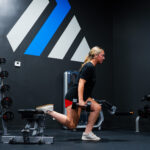Sports Specific Training for Tennis Players
Tennis is a game of speed, control, and endurance. But if you want to elevate your performance and prevent injury, you need more than match play. Sports specific training for tennis focuses on the exact movements and energy systems used in the sport—so you move faster, hit harder, and stay strong throughout the match.
This kind of targeted training creates a complete athlete, one who’s ready for every sprint, serve, and shot.
What Tennis Requires Physically
Tennis challenges both your anaerobic and aerobic systems. Every match involves:
-
Short bursts of speed
-
Multi-directional movement
-
Core and shoulder control
-
Upper-body endurance
-
Mental and muscular stamina
To meet these demands, your training must reflect the sport. That’s where sports specific training comes in.
Benefits of Sports Specific Training for Tennis
1. Enhanced Agility and Footwork
Quick direction changes are vital. Foot speed and body control improve dramatically with agility drills.
2. Improved Core and Rotational Power
The core drives all racquet swings. Strength here means more powerful serves and better injury prevention.
3. Better Shoulder Durability
Repetitive serving and hitting can wear down the shoulder. Proper training builds resilience.
4. Greater Endurance
Tennis matches can last hours. Training conditions your body to maintain performance through long sets.
5. Injury Prevention
Knees, ankles, and elbows are at risk. Targeted exercises strengthen vulnerable joints and tissues.
Weekly Tennis Training Schedule
| Day | Focus |
|---|---|
| Monday | Lower body and footwork agility |
| Tuesday | Core and rotational strength |
| Wednesday | Active recovery + shoulder mobility |
| Thursday | Plyometrics and on-court movement drills |
| Friday | Full-body strength and balance training |
| Saturday | Simulated match play + speed circuits |
| Sunday | Rest and flexibility work |
Best Sports Specific Exercises for Tennis
Lateral Shuffle with Medicine Ball Toss
Purpose: Improve footwork and upper-body power
How to do it: Shuffle side to side, tossing a ball against a wall or with a partner after each slide. 3 sets of 20 seconds.
Split-Step Reactive Drill
Purpose: Train reaction and movement from ready position
How to do it: From an athletic stance, react to a coach or partner’s direction and sprint that way. Repeat 5 times.
Pallof Press
Purpose: Strengthen anti-rotation core stability
How to do it: Hold a band at chest height, step away from anchor, and press out straight. Keep core tight. 3 sets of 10 per side.
Reverse Lunges with Rotation
Purpose: Build leg strength and rotational mobility
How to do it: Step back into a lunge and twist over the front leg. Return and switch legs.
Shoulder Internal/External Rotations
Purpose: Strengthen rotator cuff and prevent shoulder injury
How to do it: Use light bands to rotate the arm inward and outward at the shoulder joint. 3 sets of 12 per direction.
Movement Skills Every Tennis Player Needs
Your training should also improve your:
-
First-step quickness
-
Court coverage efficiency
-
Acceleration from a dead stop
-
Balance while reaching or lunging
-
Deceleration control to prevent injury
These are built through agility ladders, cone drills, band-resisted sprints, and change-of-direction training.
Importance of Recovery and Flexibility
Recovery is crucial for tennis players. Include:
-
Foam rolling
-
Daily stretching (especially hamstrings and hips)
-
Shoulder and elbow mobility
-
Proper hydration and nutrition
-
Ice or heat therapy as needed
Training hard without recovery leads to fatigue, injury, and poor performance.
Learn more recovery strategies from this Healthline tennis workout guide.
How to Train Like a Pro
Professional tennis players don’t just practice their swing—they use sports specific training to become faster, stronger, and more resilient. At Next Level Athletics, athletes receive customized tennis training plans built around mobility, power, and performance.
From juniors to seasoned players, the programs are designed to help you move better, hit harder, and compete longer.
Conclusion: Move Like a Champion
Your game improves when your body performs at its best. Sports specific training for tennis gives you the tools to move explosively, recover faster, and reduce the risk of injury.
If you’re serious about taking your game to the next level, it’s time to train like it.


Recent Comments